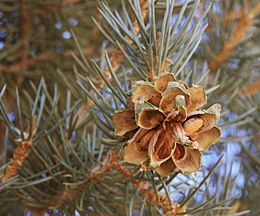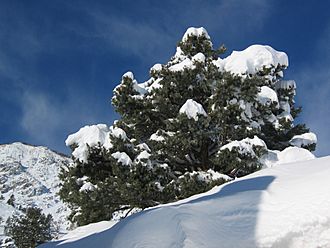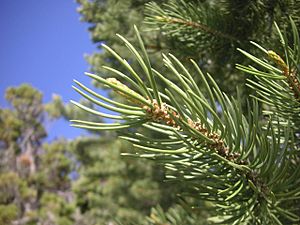Single-leaf pinyon facts for kids
Quick facts for kids Single-leaf pinyon |
|
|---|---|
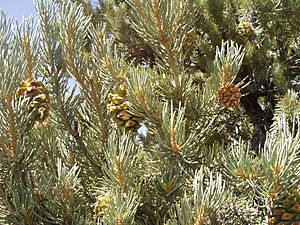 |
|
| Single-leaf pinyon (Pinus monophylla subsp. monophylla) leaves and immature cones | |
| Conservation status | |
| Scientific classification | |
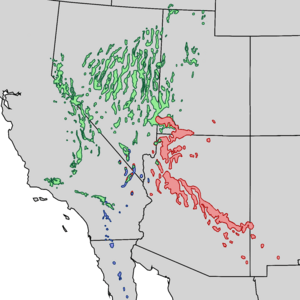 |
|
| Natural range: green – Pinus monophylla subsp. monophylla blue – Pinus monophylla subsp. californiarum red – Pinus monophylla subsp. fallax |
The Single-leaf Pinyon (scientific name: Pinus monophylla) is a special type of pine tree. It's part of a group called pinyon pines, which are known for their edible seeds. This tree grows naturally in North America. You can find it in places like southern Idaho, western Utah, Arizona, New Mexico, Nevada, and parts of California and Baja California.
These trees usually grow at medium heights, from about 1,200 to 2,300 meters (around 3,900 to 7,500 feet) above sea level. Sometimes they grow lower or higher. The Single-leaf Pinyon is very common in these areas. It often forms open forests, sometimes mixed with juniper trees. What makes this tree truly unique is that it's the only pine tree in the world that usually has just one needle per cluster!
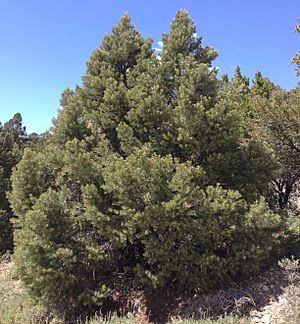
Contents
What Does the Single-leaf Pinyon Look Like?
The Single-leaf Pinyon is a small to medium-sized tree. It can grow to be about 10 to 20 meters (33 to 66 feet) tall. Its trunk can be up to 80 centimeters (31 inches) wide. The bark is rough and scaly.
Its Unique Needles and Cones
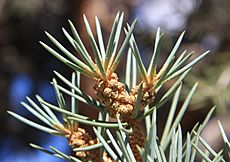
The leaves, which we call needles, are usually single. This is very unusual for a pine! They are thick, about 4 to 6 centimeters (1.5 to 2.5 inches) long. Their color can be grey-green or a cool blue-green.
The cones are roundish and quite large for a pinyon pine. They are about 4.5 to 8 centimeters (1.7 to 3 inches) long. When they are young, they are green. They take a long time to ripen, about 18 to 20 months! This means you can often see both new green cones and older, open brown cones on the tree at the same time.

How Seeds Grow and Spread
When the cones are ready, they open up to about 6 to 9 centimeters (2.3 to 3.5 inches) wide. They hold the seeds on their scales. The seeds are about 11 to 16 millimeters (0.4 to 0.6 inches) long. They have a thin shell and a white inside.
The seeds are often called "pine nuts." The pinyon jay bird helps to spread these seeds. The jay picks the seeds out of the open cones. It buries many of them to eat later. Some of these buried seeds are not eaten and can grow into new trees. In fact, pinyon seeds usually need to be buried by animals to grow in the wild!
Different Types of Single-leaf Pinyon
There are three main types, or subspecies, of the Single-leaf Pinyon:
- Pinus monophylla subsp. monophylla: This is the most common type. Its needles are thick and bright blue-green.
- Pinus monophylla subsp. californiarum: Found in southern Nevada and parts of California and Baja California. Its needles are thinner and gray-green.
- Pinus monophylla subsp. fallax: Grows near the Colorado River valley. Its needles are also thinner and gray-green.
Sometimes, the Single-leaf Pinyon can mix with other pinyon pines. For example, it can hybridize (mix genes) with the Colorado pinyon where their ranges meet. This can result in trees that have both single needles and two-needled clusters.
Mojave Desert Discovery
In the Mojave National Preserve in California, there's a group of Single-leaf Pinyon trees that mostly have needles in pairs. For a while, people thought they were Colorado pinyons. But scientists later found out, using special tests, that they are actually a two-needled version of the Single-leaf Pinyon.
Where Did Pinyons Grow Long Ago?
Scientists have studied old fossil needles and pollen from pinyon trees. This helps them understand where these trees grew thousands of years ago. All three types of Single-leaf Pinyon have kept their own special areas for the last 40,000 years. The northern type spread a lot across Utah and Nevada after the last Ice Age, about 11,700 years ago.
Uses and Importance of the Single-leaf Pinyon
The edible seeds, or pine nuts, are a very important food source. Native American people in the Great Basin region have traditionally collected and eaten them for a long time. Many birds and mammals also rely on these seeds for food. Even the roasted cones can be eaten!
People can collect these pine nuts for their own use on certain public lands.
The Single-leaf Pinyon is also grown as an ornamental tree. This means it's planted in gardens because it looks nice. It's a good choice for drought tolerant gardens because it doesn't need much water. It's also used for natural landscaping and can even be a Christmas tree. It's a bit tricky to grow from seed, so you don't often see it in plant nurseries.
In 1959, the Single-leaf Pinyon was chosen as Nevada's state tree. It was later joined by the Great Basin Bristlecone Pine. The American explorer John C. Frémont is credited with discovering this tree.
Challenges for Pinyon Woodlands
In the mid-1800s, many pinyon forests were cut down. The wood was used to make charcoal for processing ores from mines. This was a big problem for Native Americans who depended on the trees for food. Later, when railroads brought in coal, people stopped making charcoal from pinyon trees.
After the trees started to grow back, some cattle ranchers worried that the forests meant less grass for their livestock. In the 1950s, there were big efforts to clear these woodlands, sometimes by dragging a heavy chain between two bulldozers. However, these efforts stopped when it became clear that clearing the trees didn't actually help the grass grow more in the long run. Some people see the destruction of these pinyon forests for mining and ranching as a harmful act against nature and culture.
Images for kids
See also
 In Spanish: Pino monoaguja para niños
In Spanish: Pino monoaguja para niños



